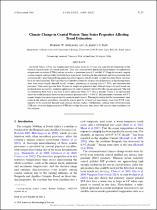| dc.description.abstract | In South Africa, 129 in situ temperature time series of up to 43 years are used for investigations of the
thermal characteristics of coastal seawater. They are collected with handheld thermometers or underwater
temperature recorders (UTRs) and are recorded at precisions from 0.58 to 0.0018C. Using the natural range of
seasonal signals and variability for 84 of these time series, their length, decadal trend, and data precision were
systematically varied before fitting generalized least squares (GLS) models to study the effect these variables
have on trend detection. The variables that contributed most to accurate trend detection, in decreasing order,
were time series length, decadal trend, variance, percentage of missing data (% NA), and measurement
precision. Time series greater than 30 years in length are preferred and although larger decadal trends are
modeled more accurately, modeled significance (p value) is largely affected by the variance present. The risk
of committing both type-1 and type-2 errors increases when $5% NA is present. There is no appreciable
effect on model accuracy between measurement precision of 0.18–0.0018C. Measurement precisions of 0.58C
require longer time series to give equally accurate model results. The implication is that the thermometer time
series in this dataset, and others around the world, must be at least two years longer than their UTR counterparts to be useful for decadal-scale climate change studies. Furthermore, adding older lower-precision
UTR data to newer higher-precision UTR data within the same time series will increase their usefulness for
this purpose. | en_US |

